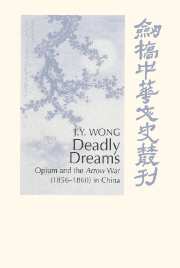Book contents
- Frontmatter
- Contents
- List of Tables
- List of Figures
- Poem by the late Mr Qin Esheng
- Foreword by Professor Wang Gungwu
- Foreword by Professor C. A. Bayly
- Preface
- Part I The confusion of imperialism
- Part II The pretext for imperialism
- Part III The personalities of imperialism
- Part IV The rhetoric of imperialism
- Part V The mechanics of imperialism
- Part VI The economics of imperialism
- 14 Anglo-Chinese trade: The Chinese should buy more
- 15 China's maritime trade: The Chinese could buy more
- 16 The problem of India: The Chinese should and could buy more
- 17 The balance sheet: The Chinese are now buying more
- Part VII The dynamics of imperialism
- Chronology of major events
- Word list
- Abbreviations
- Bibliography
- Index
17 - The balance sheet: The Chinese are now buying more
Published online by Cambridge University Press: 29 September 2009
- Frontmatter
- Contents
- List of Tables
- List of Figures
- Poem by the late Mr Qin Esheng
- Foreword by Professor Wang Gungwu
- Foreword by Professor C. A. Bayly
- Preface
- Part I The confusion of imperialism
- Part II The pretext for imperialism
- Part III The personalities of imperialism
- Part IV The rhetoric of imperialism
- Part V The mechanics of imperialism
- Part VI The economics of imperialism
- 14 Anglo-Chinese trade: The Chinese should buy more
- 15 China's maritime trade: The Chinese could buy more
- 16 The problem of India: The Chinese should and could buy more
- 17 The balance sheet: The Chinese are now buying more
- Part VII The dynamics of imperialism
- Chronology of major events
- Word list
- Abbreviations
- Bibliography
- Index
Summary
I. Imports: Tea
By the Treaty of Tientsin, the British obtained their objective of direct access to the tea-producing areas of the Yangtze basin. Whether or not their expectations were fulfilled, however, requires some examination. Table 17. I shows the quantity of tea imported from China before, during, and after the Arrow War. It extends to many years before the war in order to show a long-term pattern of development, covering thirty years in all. It ends in 1867, seven years after the conclusion of peace.
In those seven years of the postwar period, the average annual amount of tea imported from China was over 115 million pounds. Furthermore, the annual quantity remained fairly steady. During the four years of earnest hostilities, 1857–60, the annual average was about 72 million pounds. During the four years before just the war, 1853–6, the annual average was about 79 million pounds. These figures suggest that there was a marked increase in the availability of tea after free access was obtained to the tea-growing area of the Yangtze. More important, these teas were bought much more cheaply than before, being now free from both the transit dues levied between the producing areas and the treaty ports, and the charges of Chinese middlemen.
The four years before the war, 1853–6, were marked by disturbances in China. By 1853, the Taipings had captured Nanjing on the Yangtze River. The Taipings’ occupation of the lower Yangtze area starved Shanghai of tea and silk for export.
- Type
- Chapter
- Information
- Deadly DreamsOpium and the Arrow War (1856–1860) in China, pp. 434 - 454Publisher: Cambridge University PressPrint publication year: 1998



